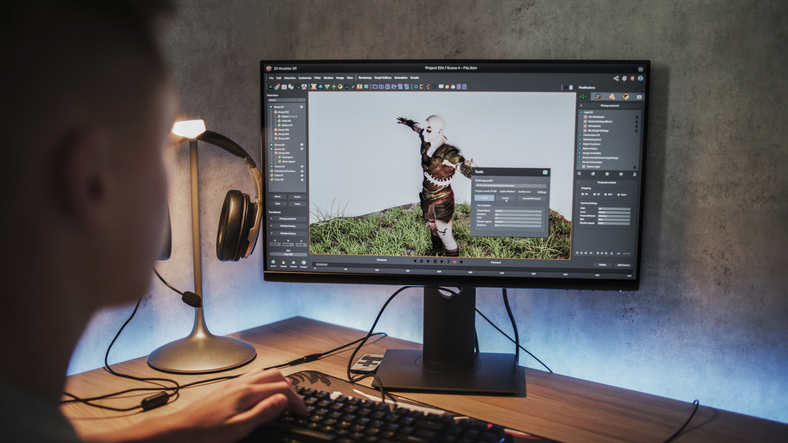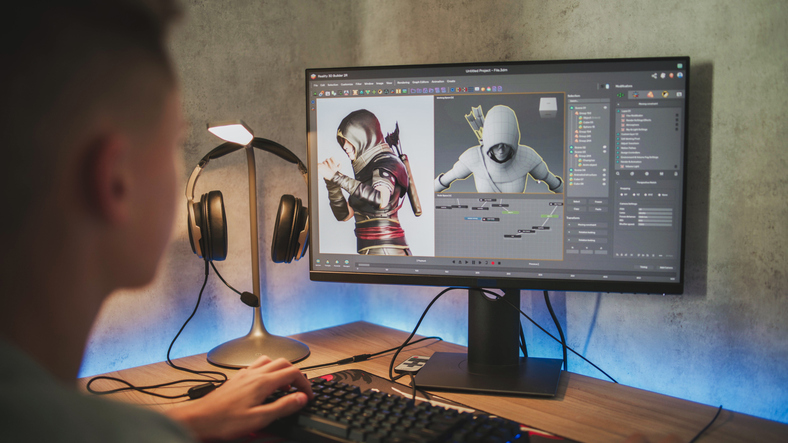Graphic design is a vibrant, ever-changing field where creativity meets functionality. Whether you are considering a career shift, freshly graduating from high school, or looking to sharpen your creative skills, building an exceptional graphic design portfolio is your golden ticket into this exciting industry. A strong portfolio is your introduction, your handshake, and your first impression to potential employers and clients. But how exactly do you craft a portfolio that truly shines?
Luckily, VCAD’s Graphic Design Diploma offers students the perfect blend of practical skills and creative exploration, preparing you not only to build a remarkable portfolio but also to thrive in the competitive design industry.
What is a Graphic Design Portfolio?
A graphic design portfolio is a carefully curated collection displaying your best creative work. It serves as your professional introduction, visually communicating your technical proficiency, artistic style, creative thinking, and ability to solve design problems effectively. Unlike a traditional résumé, which simply lists your experiences and skills, your portfolio provides tangible evidence of your capabilities and creative process.
Your graphic design portfolio reflects who you are as a designer, capturing your unique perspective, personal design philosophy, and the diverse range of your creative abilities. It includes projects that illustrate your versatility across various design mediums, from digital and web design to print and illustration. By carefully selecting and presenting your strongest projects, your portfolio becomes a compelling visual narrative that displays your professional growth and communicates the value you can bring to potential employers, clients, and collaborators.
Understanding the Importance of a Graphic Design Portfolio
Your graphic design portfolio is far more than a collection of your artwork or past projects. It is the cornerstone of your professional identity and your most compelling tool to communicate who you are as a designer. Whether you are starting your career or advancing to the next level, the value of a strong graphic design portfolio cannot be overstated. Here is why:
1. Demonstrates Your Skills and Expertise Your portfolio displays your ability to effectively apply design principles, master industry-standard tools, and produce innovative solutions. It provides concrete proof of your competencies in various design disciplines.
2. Highlights Your Unique Style Each designer has a unique approach and aesthetic. A portfolio clearly reflects your distinctive creative voice, enabling employers and clients to understand your personal style and envision how it aligns with their needs.
3. Validates Your Professional Credibility Employers and clients trust visible evidence of your past successes over claims of experience. Your portfolio validates your professional credibility by presenting real, tangible outcomes from previous projects.
4. Facilitates Career Growth A well-structured portfolio opens doors to numerous opportunities, including internships, freelance gigs, full-time employment, and collaborative projects. It is your ticket to continuous career advancement.
5. Makes a Memorable First Impression In graphic design, first impressions matter significantly. A compelling portfolio grabs attention immediately, leaving a lasting impression on potential employers or clients and increasing your chances of being remembered and selected.
Investing time and effort into developing a high-quality graphic design portfolio is vital. It positions you effectively in a competitive market, clearly communicates your unique strengths, and acts as your strongest advocate in your graphic design career journey.
How to Build a Graphic Design Portfolio
Building a graphic design portfolio involves careful planning and thoughtful selection. Here is how you can do it from scratch:
1. Pick a Platform
Choosing the right platform to host your portfolio is the initial and crucial step. Consider platforms like Adobe Portfolio, Squarespace, Wix, Weebly, or WordPress. These user-friendly sites provide templates that make assembling your portfolio straightforward. Explore their features and consider which platform suits your personal style, technical comfort, and budget.
VCAD’s Graphic Design Diploma guides you through this process, ensuring your portfolio is professionally presented and easy to update as your skills develop. You can also host your portfolio on VCAD’s website if you are a student of VCAD.
2. Assemble Your Work
Your portfolio should include around 10-15 of your strongest works, representing your abilities and style clearly. Diversity is key show a variety of design projects such as branding, web design, illustration, packaging, and advertising. If your goal is a niche market, tailor your portfolio, accordingly, focusing deeply on one area to attract specific employers or clients.
VCAD’s program provides numerous opportunities to create real-world projects, giving you diverse work to display your versatility.
3. Include Descriptions
Each piece in your portfolio should tell a story. Include short, engaging descriptions that explain your design process, challenges faced, and solutions provided. Highlight the project's purpose and your specific contributions to clearly demonstrate your problem-solving skills and creative thought processes.
Read More: What to Put in Your Graphic Design Portfolio
Essentials of a Strong Graphic Design Portfolio
To ensure your portfolio stands out, consider the following essential elements:
- Quality over Quantity: Present only your very best work. Each piece should serve a clear purpose and represent your top skills.
- Consistent Branding: Maintain a cohesive look throughout your portfolio. Use consistent typography, colour schemes, and layout styles.
- Professional Presentation: Organize your work neatly. Make navigation simple and intuitive.
- Mobile Responsiveness: Ensure your portfolio looks and functions well across various devices computers, tablets, and mobile phones.
Showcasing Your Design Process and Personal Brand
Your portfolio is not finished products; it is also about the journey. Highlight your creative process by sharing sketches, early drafts, and conceptual developments. Demonstrating how you approach and solve design challenges gives potential clients or employers insight into your problem-solving abilities and creative mindset.
At VCAD, you will learn how to communicate your creative process effectively, capturing your unique brand and personality in your portfolio.
Leveraging Online Platforms
Beyond your primary portfolio site, consider leveraging online platforms such as Behance, Dribbble, Instagram, and LinkedIn to widen your reach. These platforms allow you to highlight your work to a broader audience and connect with industry professionals and potential clients. Actively engaging on these sites can significantly enhance your visibility in the graphic design community.
Practical Tips and Best Practices
- Regular Updates: Keep your portfolio fresh and relevant by frequently adding new projects and removing outdated work.
- Accessibility: Use alt-text for images and ensure responsive design for users with disabilities.
- Tailor Your Portfolio: Adjust your portfolio for specific jobs or clients by highlighting relevant skills and projects.
- Client Testimonials: Include positive feedback from clients or professors to build credibility.
How VCAD Helps You Build Your Portfolio
VCAD's Graphic Design Diploma uniquely positions students for success in the competitive design market by offering:
- Comprehensive Training: You will gain practical, industry-relevant skills in typography, layout design, digital photography, web design, branding, and packaging design.
- Expert Guidance: Learn directly from experienced industry professionals who guide you through each project.
- Personalized Learning: Flexible online delivery modes allow you to study at your pace while receiving tailored support.
- Industry-Standard Tools: Work with cutting-edge software like Adobe Illustrator and Photoshop, ensuring your industry-ready.
- Professional Portfolio Development: By graduation, you will have a polished, professional portfolio that highlights your strengths and makes a strong impression on potential employers.
Career Opportunities with a Strong Portfolio
A well-constructed portfolio significantly expands your career opportunities. Graduates of VCAD’s Graphic Design Diploma often pursue rewarding roles such as:
- Graphic Designer
- Illustrator
- Web Designer
- Layout Designer
- Advertising Designer
- Digital Media Artist
The graphic design field offers competitive salaries and the flexibility to work in diverse industries like marketing, advertising, publishing, and digital media.
Building a graphic design portfolio is not collecting your past projects it is about crafting a visual narrative that displays your creativity, skills, and professional growth. VCAD’s Graphic Design Diploma program equips you with the tools, guidance, and practical experience necessary to create a standout portfolio and excel in this dynamic industry.
Ready to embark on a fulfilling creative journey? Explore VCAD’s Graphic Design Diploma and start building your professional graphic design portfolio today.














